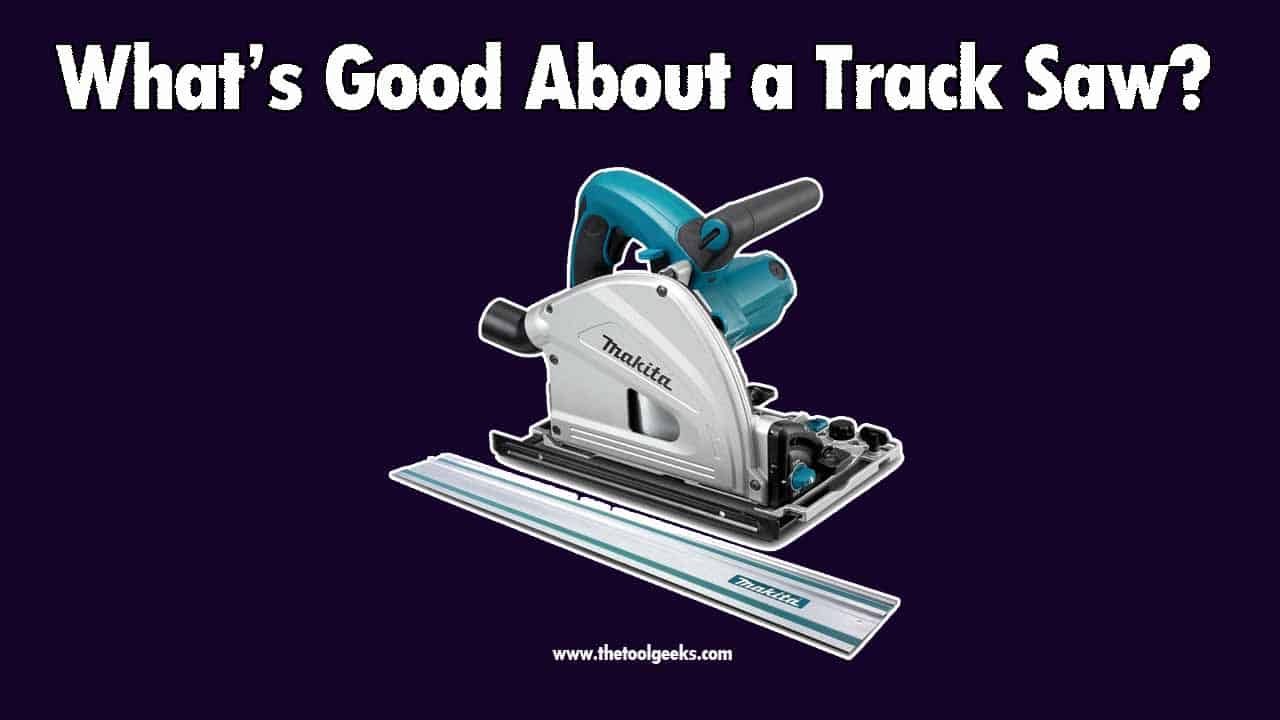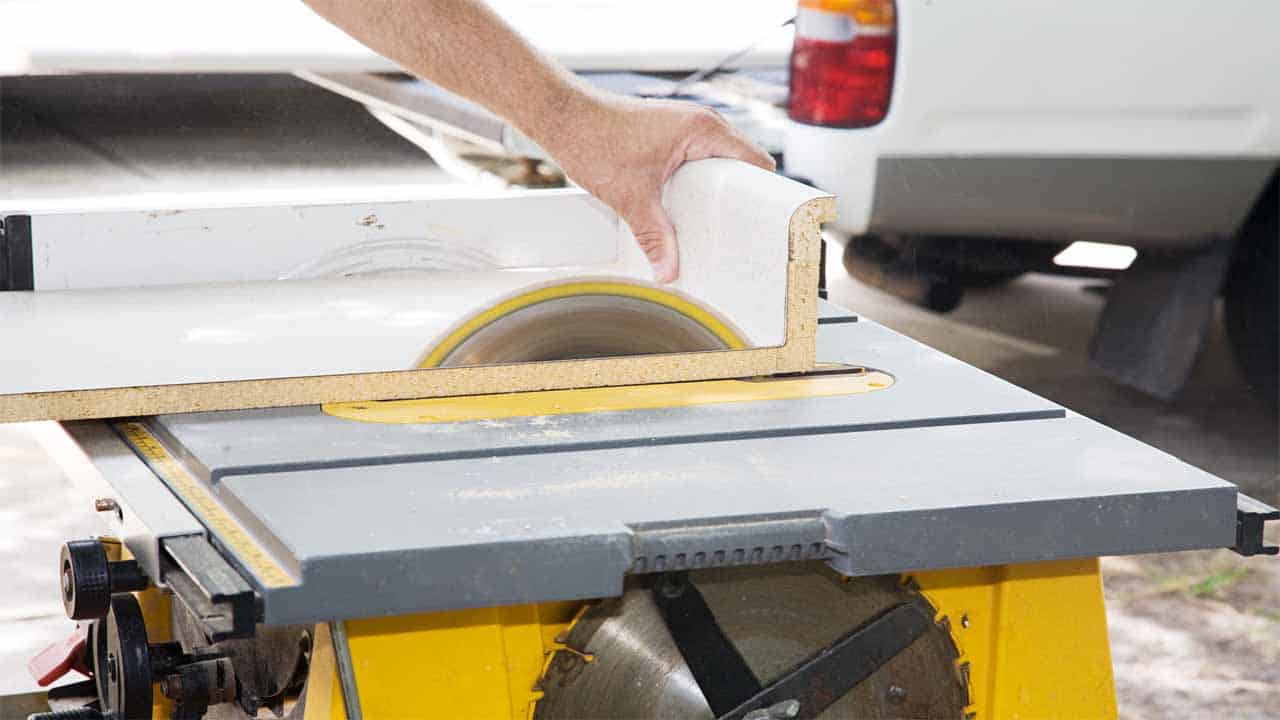Table Saw vs Track Saw: Which One Should You Choose (& Why?)
TheToolGeeks.com is a participant in the Amazon Services LLC Associates Program and other affiliate advertising programs. We may earn from qualifying purchases. (Learn More).
With the rise of the track saw, we need to ask – which is better to invest in, a table saw vs track saw? That depends greatly on your needs, but the table saw has key drawbacks for the woodworker on the go. That’s not to say that it is completely replaced by the track saw though!
Looking at the key strengths and weaknesses of the table saw and the track saw, we will look at how to get the most out of the saws that you own and if you should think about expanding your arsenal of power tools.
Jump To Page Contents:
Related Read — Battery-Powered Table Saw Review
What’s Good About a Track Saw?
A track saw is an impressive tool that takes almost all of the features from the table saw and makes it portable. What more could you ask for?

The simple set up that rarely needs more than simply setting it over whatever you need to cut means that it can be taken anywhere that you can fit the track.
Portability
The main strength of the track saw is it’s portability – whereas taking a table saw anywhere with you is practically impossible without a specialized van, you can pick up the track saw and transport it easily to wherever you are physically capable of carrying it. The track bar (the piece that actually guides the saw) can be picked up and easily moved around.
Versatility
This greater versatility means that you can cut down on the kind of equipment that you have to carry around with you. To the uneducated eye, a track saw looks like a circular saw attached to a track.
Even though this is not true, it is true that the track saw can double up as a rather cumbersome circular saw. That means that it also has most of the versatility and use of a circular saw.
Related Read — Best Cabinet Table Saws
Variety of Cuts
The main cuts that a track saw is designed for are cross cuts, plunge cuts, angular cuts, miter cuts, and rip cuts. A very extensive repertoire!
And again, this can all be done on-site. If you have a track saw, you know that you can carry out most jobs without any extra equipment.
Cutting Different Boards
An additional strength is that the track saw can be used on any size of the board. There is no fence (unlike a table saw), so you are simply limited by the amount of space you have to fit a track saw in.
Working Alone With Larger Boards
Cutting heavy boards can be difficult with other kinds of saws. As long as the saw is firmly placed on a material that is thick enough, there are no problems making cuts into heavy or larger boards.
The lack of a fence isn’t a limiting factor but makes jobs that are difficult with fences or jigs relatively easy.
Making Non-square Cuts
Another key strength of the track saw is the ability to cut across a board in a way that isn’t square to either side.
You can simply lay the track down over your material in any direction you need and make your cut. The track will act as a weight and jig for your blade, meaning you just need to focus on getting the correct depth and speed.
Storage
As the track saw is easily portable, it can be picked up and carried to a safe space on your work site so that no one gets injured.
They are also significantly smaller than a table saw, meaning that you can move them out of the way and use less space than a literal table.
Safety
Saws are only as safe as the user that is operating them, but the track saw is largely idiot-proof. The blade plunges beneath a metal track, meaning that it is almost impossible to get your fingers or any other body part underneath the blade while operating it.
This added safety measure may be attractive to newcomers, especially considering the table saw’s a dangerous-looking spinning blade (which in practice is just as safe the worker using it!)
What’s Good About a Table Saw?
Although it’d be easier to list the weaknesses of a table saw, it’s good to lay out the key strengths. The table saw is a staple of any serious woodworker for good reason – the versatility of the tool cannot be overstated.

Even if you are only a hobbyist woodworker, investing in a table saw can greatly increase the type and amount of work you can do.
Accuracy
They are extremely accurate tools that can cut a variety of boards with ease. Whether your board is narrow, wide, short, or long, you can make an appropriate guide or fit a jig that allows for a series of identical cuts. This versatility is difficult to replicate without using at least 2 other tools.
Related Read — How to Cut a Taper on a Table Saw?
Deep cuts
Making deep cuts on thick blocks is also possible with a table saw as the blades can be up to 12 inches wide, allowing for a cutting distance of up to 4 inches.
This kind of depth is not possible with a circular or track saw as their blades generally can go no further than 2 inches.
Making Awkward Cuts
The table saw is also excellent for making cuts that are extremely awkward with other power tools. The most obvious are cutting small pieces which holding a saw over would be difficult without proper supports and clamps.
Although these are possible with other tools, they take up a lot of time. Maybe this isn’t an issue for a hobbyist, but the professional woodworker needs to consider this a key aspect of the job!
Narrow Rip Cuts
Similarly, cutting narrow rip cuts is possible with a table saw where it is extremely difficult for other tools.
This is especially true for the track saw – the track means that it is cumbersome at best and outright dangerous at worst to try to cut a narrow board without extensive support and clamping. For the table saw, it is a two-minute job.
Related Read — Different Types of Table Saws Explained
Repeatability
The speed of a table saw is fantastic with the proper setup. You simply need to set your fence or guide block up correctly and you can instantly feed different pieces of wood over the saw.
This means that it is perfect for cutting the exact same finish quickly with multiple types of wood. Some even band a small number of pieces of wood together (thin wood that can fit below the fence, ideally) to make clean cuts that are exact copies of each other.
What Is the Key Strength of the Table Saw?
If you can find a place for the table saw, it is an excellent tool for a variety of jobs. It offers speed, a variety of cut depths (including a very deep cut), and a variety of cuts.
If you have enough space in your workshop or even on a worksite, it really is one of the most useful pieces of machinery that you will add to your arsenal.
However, the key strength is the use of deep cuts, especially with hardwood. The track saw cannot compete without the use of additional hardware, meaning that it is difficult to get the same quality of cuts without a headache about which tools to bring to a site.
Related Read — Table Saw vs Bandsaws
Table Saw vs Track Saw: Which One Is Faster?
Time is money. This is especially true in the woodworking trade; you need to be able to produce and sell high-quality products consistently if you want to make a living from it. That means the speed of a cut and the set-up time is important for every piece of equipment you own.
In terms of set up, the table saw takes longer overall. It’s a literal table, meaning that it’s difficult to transport around and needs to be stored in a workshop.
If you have a job that needs a table saw and cannot be done with any other tool, this means packing up the materials, heading back to your workshop, and then taking the newly cut material back to the site.
This can be counted by using a portable, foldable table saw, but even they are cumbersome pieces of equipment. If you have enough space at your worksite to justify having a portable table saw, that will greatly cut down on the amount of time you have to spend transporting materials.
Due to the track saw portability, you instantly cut down on transport times as you will never have to bring materials to it. You can simply pick the track up and head to work, knowing that the track saw’s incredible versatility with account for the needs of many jobs you will have to work on throughout the day.
When the material is on the table, however, the table saw cuts faster. This is due to the large blade and ability to cut multiple pieces of wood at the same time.
Not only can you use the blade to get accurate cuts, but appropriately prepared boards can be cut at the same time. This is difficult with a track saw as the blade is almost always much smaller.
Which Is Better Between the Table Saw and the Track Saw?
This greatly depends on your circumstances. Depending on the cut you need to make, both the table saw and the track saw are incredibly useful tools that will give you accurate, faster cuts and turn your jobs into professional finishes.
There is one case where the table saw completely wins out, however – ripping narrow boards. A track on a track saw is a certain width, generally only slightly larger than the shoe. If you need to rip a board that is narrower than this, you are creating a dangerous environment.
Leaning the track onto a piece of wood that is narrower than the track gives you an insecure foundation, a high risk of slipping, and a significant chance that you will ruin the wood that you are working on.
This can be counteracted by setting up a range of supports and clamps to hold the wood in place, but this again eats into your time.
If you have access to a table saw, there is no need to use a track saw (or literally any other saw) for a narrow rip cut. Your best friend for this kind of job is the table saw’s easy feeding technique.
Related Read — Table Saw 101: Making Angled Cuts
Conclusion
Even though we offered our ideas about why the table saw is better for a specific purpose that the track saw just cannot compete with, we would be giving bad advice if we didn’t say that they are both useful and can increase productivity clearly.
If you are the kind of workman or workwoman who is often on the move, the track saw might be an attractive purchase.
It gives you the capability of a table saw and a circular saw combined. Saving space in your van and saving time on the worksite is important, so this attractive tool can be both powerfully useful and space-efficient.
If you expect you will be making a variety of cuts into woods of varying sizes, the table saw might work better as a first purchase. Its versatility beats out the track saw (itself an incredibly versatile tool to have on a worksite), so this piece of equipment can really help you improve productivity wherever you use it.
Still, for any keen woodworker, getting both tools should be high on their wish list. Much like any professional, a woodworker needs to get the appropriate tools to excel in their profession.
Although there are some small benefits to only buying one, owning both a table and track saw will greatly increase the kind of profession, clean cuts that you can perform to keep your customers happy.
Now that you know the differences between a table saw vs track saw, do you have any questions? If yes, then make sure to comment down below.
Amazon and the Amazon logo are trademarks of Amazon.com, Inc, or its affiliates.

